Qualitative Research Critique: Patient Falls & Adult Nursing Practice
VerifiedAdded on 2023/06/12
|18
|4763
|154
Essay
AI Summary
This essay offers a detailed critique of a qualitative research paper focusing on patient perceptions and experiences with falls during hospitalization and after discharge. It assesses the research's believability based on writing style, author credentials, title clarity, and abstract completeness, identifying limitations in the title and research structure. The critique addresses the significance of the research problem, the study's purpose, and the literature review's effectiveness in identifying knowledge gaps. It further evaluates the research methods, study design, and philosophical underpinnings, highlighting the use of qualitative research to understand patient opinions on falls. The essay concludes by discussing the research's fit within current evidence-based nursing practice and its theoretical framework, ultimately emphasizing the value of the research in contributing to patient-centered care and future nursing practice improvements; solved assignments for similar papers are available on Desklib.
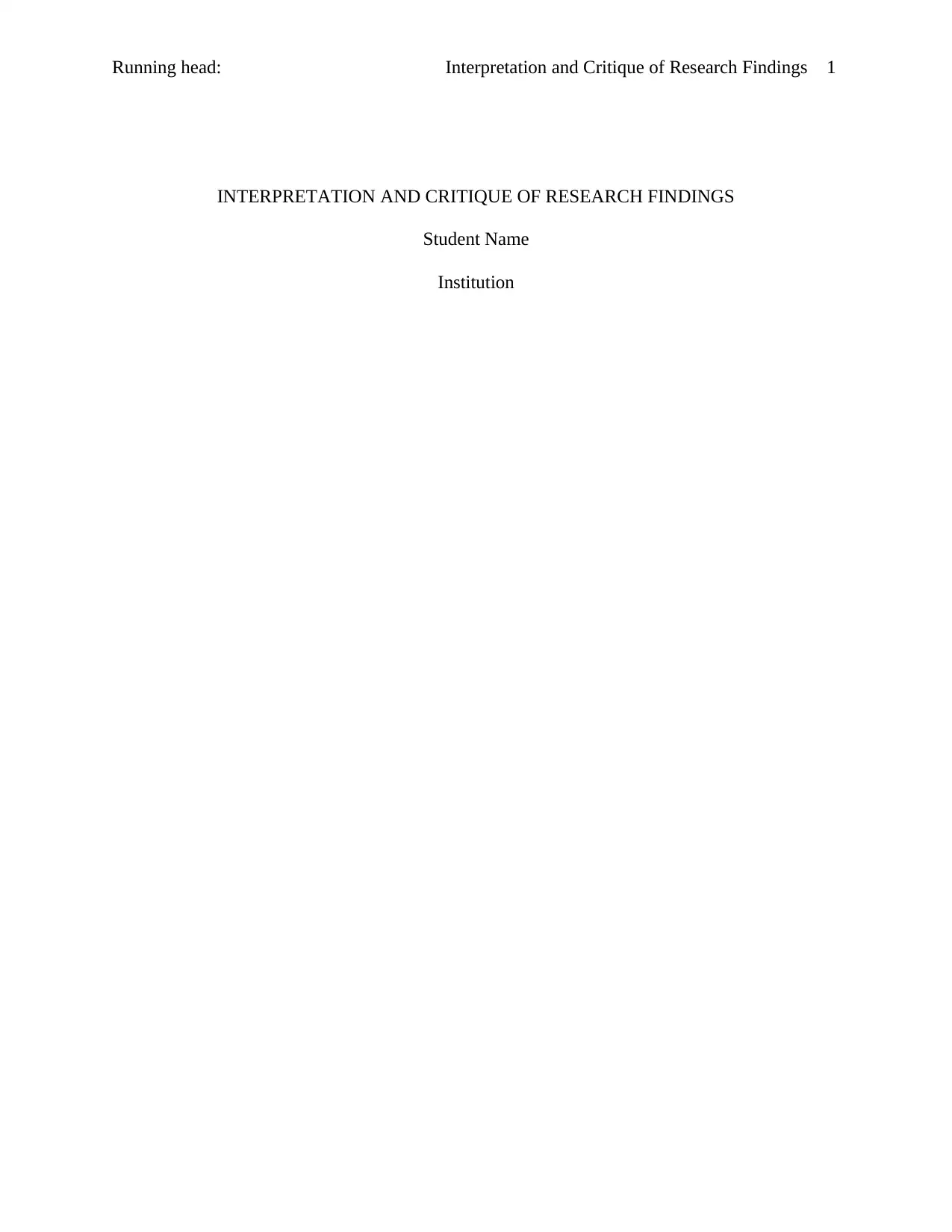
Running head: Interpretation and Critique of Research Findings 1
INTERPRETATION AND CRITIQUE OF RESEARCH FINDINGS
Student Name
Institution
INTERPRETATION AND CRITIQUE OF RESEARCH FINDINGS
Student Name
Institution
Paraphrase This Document
Need a fresh take? Get an instant paraphrase of this document with our AI Paraphraser
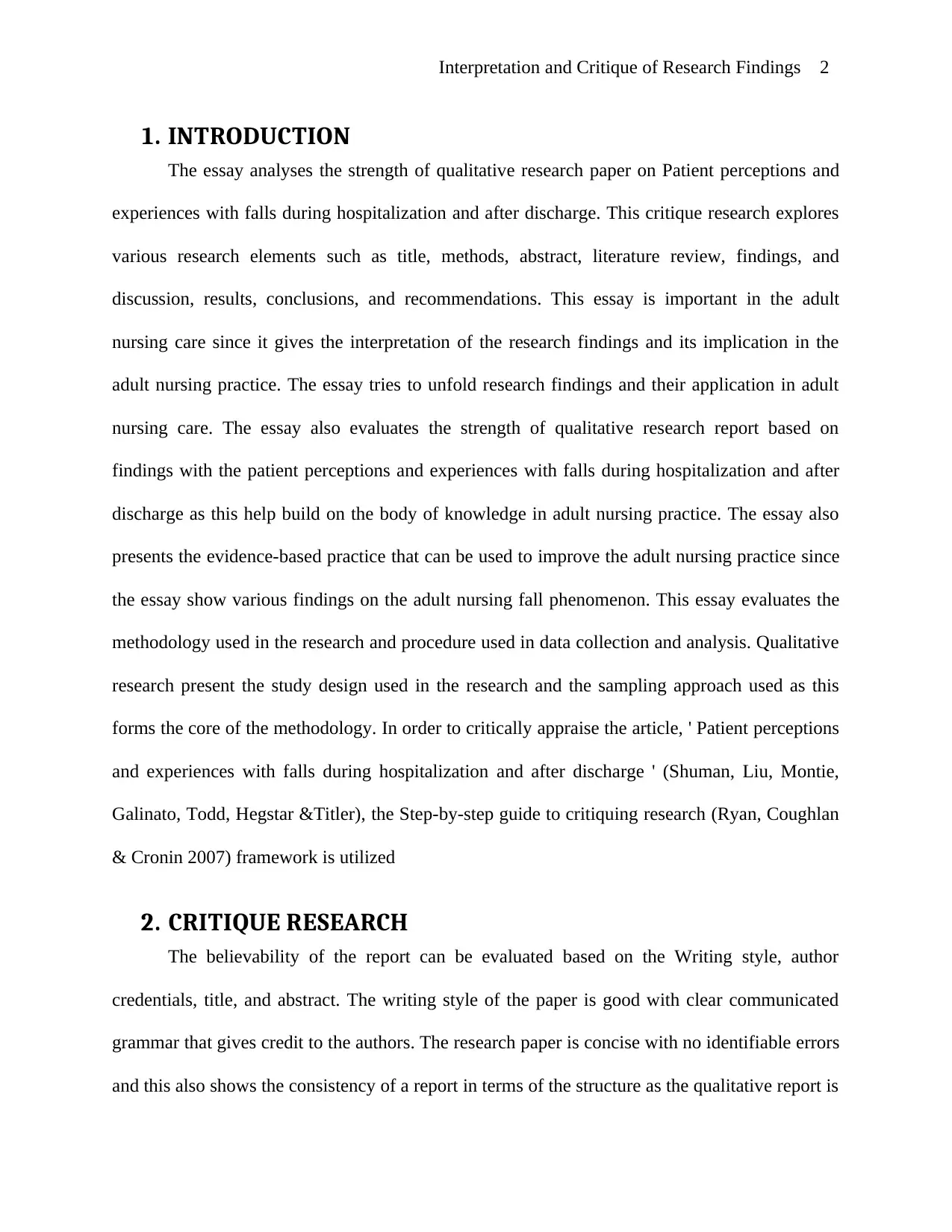
Interpretation and Critique of Research Findings 2
1. INTRODUCTION
The essay analyses the strength of qualitative research paper on Patient perceptions and
experiences with falls during hospitalization and after discharge. This critique research explores
various research elements such as title, methods, abstract, literature review, findings, and
discussion, results, conclusions, and recommendations. This essay is important in the adult
nursing care since it gives the interpretation of the research findings and its implication in the
adult nursing practice. The essay tries to unfold research findings and their application in adult
nursing care. The essay also evaluates the strength of qualitative research report based on
findings with the patient perceptions and experiences with falls during hospitalization and after
discharge as this help build on the body of knowledge in adult nursing practice. The essay also
presents the evidence-based practice that can be used to improve the adult nursing practice since
the essay show various findings on the adult nursing fall phenomenon. This essay evaluates the
methodology used in the research and procedure used in data collection and analysis. Qualitative
research present the study design used in the research and the sampling approach used as this
forms the core of the methodology. In order to critically appraise the article, ' Patient perceptions
and experiences with falls during hospitalization and after discharge ' (Shuman, Liu, Montie,
Galinato, Todd, Hegstar &Titler), the Step-by-step guide to critiquing research (Ryan, Coughlan
& Cronin 2007) framework is utilized
2. CRITIQUE RESEARCH
The believability of the report can be evaluated based on the Writing style, author
credentials, title, and abstract. The writing style of the paper is good with clear communicated
grammar that gives credit to the authors. The research paper is concise with no identifiable errors
and this also shows the consistency of a report in terms of the structure as the qualitative report is
1. INTRODUCTION
The essay analyses the strength of qualitative research paper on Patient perceptions and
experiences with falls during hospitalization and after discharge. This critique research explores
various research elements such as title, methods, abstract, literature review, findings, and
discussion, results, conclusions, and recommendations. This essay is important in the adult
nursing care since it gives the interpretation of the research findings and its implication in the
adult nursing practice. The essay tries to unfold research findings and their application in adult
nursing care. The essay also evaluates the strength of qualitative research report based on
findings with the patient perceptions and experiences with falls during hospitalization and after
discharge as this help build on the body of knowledge in adult nursing practice. The essay also
presents the evidence-based practice that can be used to improve the adult nursing practice since
the essay show various findings on the adult nursing fall phenomenon. This essay evaluates the
methodology used in the research and procedure used in data collection and analysis. Qualitative
research present the study design used in the research and the sampling approach used as this
forms the core of the methodology. In order to critically appraise the article, ' Patient perceptions
and experiences with falls during hospitalization and after discharge ' (Shuman, Liu, Montie,
Galinato, Todd, Hegstar &Titler), the Step-by-step guide to critiquing research (Ryan, Coughlan
& Cronin 2007) framework is utilized
2. CRITIQUE RESEARCH
The believability of the report can be evaluated based on the Writing style, author
credentials, title, and abstract. The writing style of the paper is good with clear communicated
grammar that gives credit to the authors. The research paper is concise with no identifiable errors
and this also shows the consistency of a report in terms of the structure as the qualitative report is
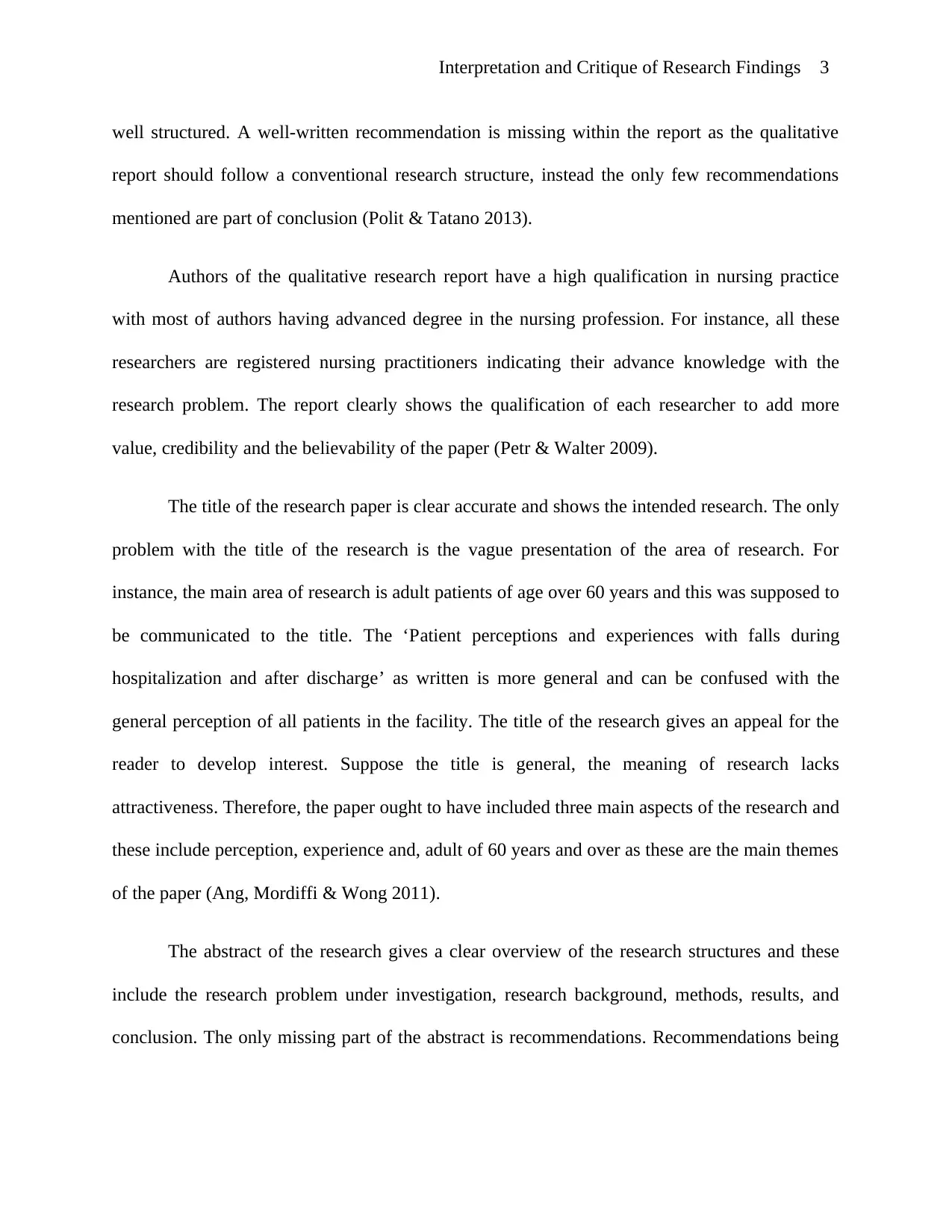
Interpretation and Critique of Research Findings 3
well structured. A well-written recommendation is missing within the report as the qualitative
report should follow a conventional research structure, instead the only few recommendations
mentioned are part of conclusion (Polit & Tatano 2013).
Authors of the qualitative research report have a high qualification in nursing practice
with most of authors having advanced degree in the nursing profession. For instance, all these
researchers are registered nursing practitioners indicating their advance knowledge with the
research problem. The report clearly shows the qualification of each researcher to add more
value, credibility and the believability of the paper (Petr & Walter 2009).
The title of the research paper is clear accurate and shows the intended research. The only
problem with the title of the research is the vague presentation of the area of research. For
instance, the main area of research is adult patients of age over 60 years and this was supposed to
be communicated to the title. The ‘Patient perceptions and experiences with falls during
hospitalization and after discharge’ as written is more general and can be confused with the
general perception of all patients in the facility. The title of the research gives an appeal for the
reader to develop interest. Suppose the title is general, the meaning of research lacks
attractiveness. Therefore, the paper ought to have included three main aspects of the research and
these include perception, experience and, adult of 60 years and over as these are the main themes
of the paper (Ang, Mordiffi & Wong 2011).
The abstract of the research gives a clear overview of the research structures and these
include the research problem under investigation, research background, methods, results, and
conclusion. The only missing part of the abstract is recommendations. Recommendations being
well structured. A well-written recommendation is missing within the report as the qualitative
report should follow a conventional research structure, instead the only few recommendations
mentioned are part of conclusion (Polit & Tatano 2013).
Authors of the qualitative research report have a high qualification in nursing practice
with most of authors having advanced degree in the nursing profession. For instance, all these
researchers are registered nursing practitioners indicating their advance knowledge with the
research problem. The report clearly shows the qualification of each researcher to add more
value, credibility and the believability of the paper (Petr & Walter 2009).
The title of the research paper is clear accurate and shows the intended research. The only
problem with the title of the research is the vague presentation of the area of research. For
instance, the main area of research is adult patients of age over 60 years and this was supposed to
be communicated to the title. The ‘Patient perceptions and experiences with falls during
hospitalization and after discharge’ as written is more general and can be confused with the
general perception of all patients in the facility. The title of the research gives an appeal for the
reader to develop interest. Suppose the title is general, the meaning of research lacks
attractiveness. Therefore, the paper ought to have included three main aspects of the research and
these include perception, experience and, adult of 60 years and over as these are the main themes
of the paper (Ang, Mordiffi & Wong 2011).
The abstract of the research gives a clear overview of the research structures and these
include the research problem under investigation, research background, methods, results, and
conclusion. The only missing part of the abstract is recommendations. Recommendations being
⊘ This is a preview!⊘
Do you want full access?
Subscribe today to unlock all pages.

Trusted by 1+ million students worldwide
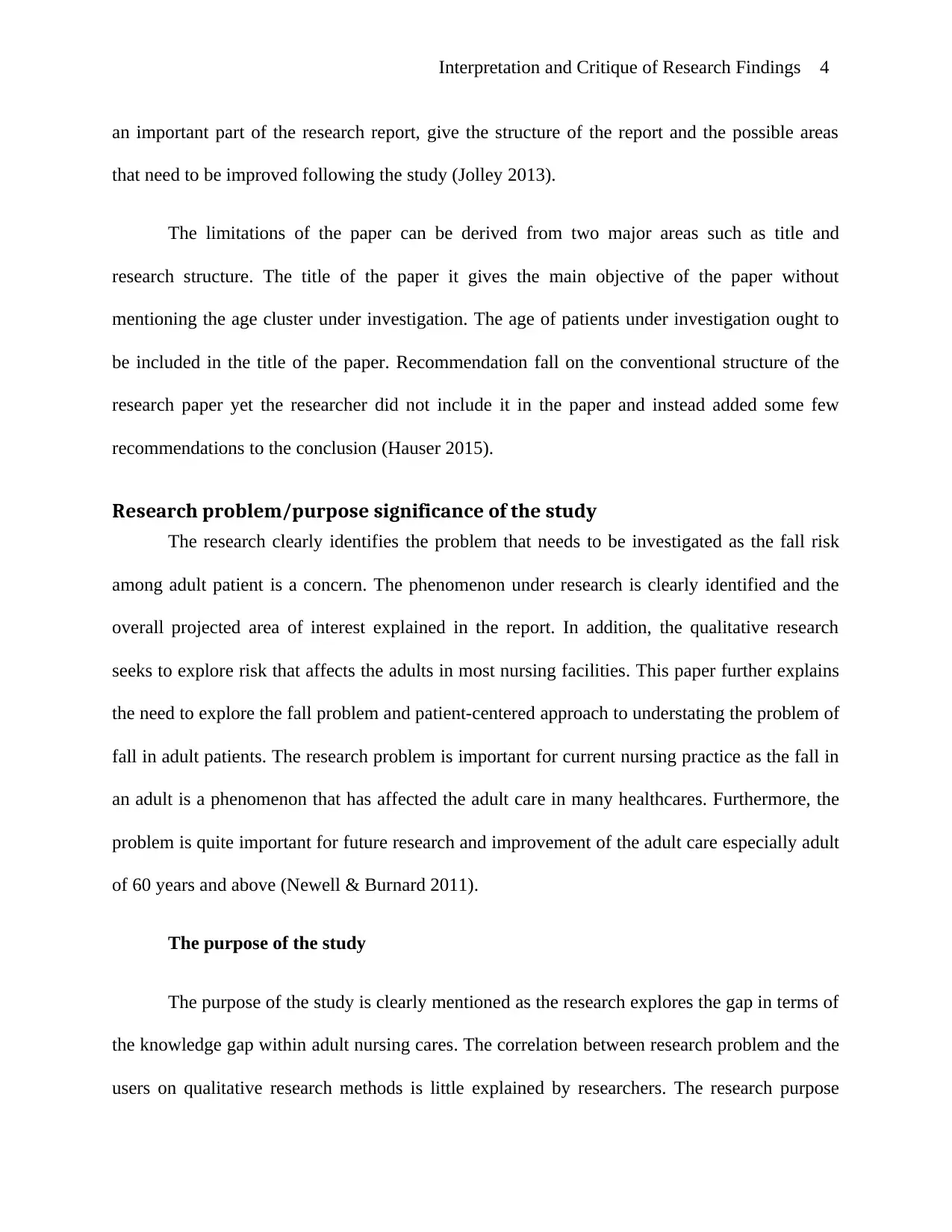
Interpretation and Critique of Research Findings 4
an important part of the research report, give the structure of the report and the possible areas
that need to be improved following the study (Jolley 2013).
The limitations of the paper can be derived from two major areas such as title and
research structure. The title of the paper it gives the main objective of the paper without
mentioning the age cluster under investigation. The age of patients under investigation ought to
be included in the title of the paper. Recommendation fall on the conventional structure of the
research paper yet the researcher did not include it in the paper and instead added some few
recommendations to the conclusion (Hauser 2015).
Research problem/purpose significance of the study
The research clearly identifies the problem that needs to be investigated as the fall risk
among adult patient is a concern. The phenomenon under research is clearly identified and the
overall projected area of interest explained in the report. In addition, the qualitative research
seeks to explore risk that affects the adults in most nursing facilities. This paper further explains
the need to explore the fall problem and patient-centered approach to understating the problem of
fall in adult patients. The research problem is important for current nursing practice as the fall in
an adult is a phenomenon that has affected the adult care in many healthcares. Furthermore, the
problem is quite important for future research and improvement of the adult care especially adult
of 60 years and above (Newell & Burnard 2011).
The purpose of the study
The purpose of the study is clearly mentioned as the research explores the gap in terms of
the knowledge gap within adult nursing cares. The correlation between research problem and the
users on qualitative research methods is little explained by researchers. The research purpose
an important part of the research report, give the structure of the report and the possible areas
that need to be improved following the study (Jolley 2013).
The limitations of the paper can be derived from two major areas such as title and
research structure. The title of the paper it gives the main objective of the paper without
mentioning the age cluster under investigation. The age of patients under investigation ought to
be included in the title of the paper. Recommendation fall on the conventional structure of the
research paper yet the researcher did not include it in the paper and instead added some few
recommendations to the conclusion (Hauser 2015).
Research problem/purpose significance of the study
The research clearly identifies the problem that needs to be investigated as the fall risk
among adult patient is a concern. The phenomenon under research is clearly identified and the
overall projected area of interest explained in the report. In addition, the qualitative research
seeks to explore risk that affects the adults in most nursing facilities. This paper further explains
the need to explore the fall problem and patient-centered approach to understating the problem of
fall in adult patients. The research problem is important for current nursing practice as the fall in
an adult is a phenomenon that has affected the adult care in many healthcares. Furthermore, the
problem is quite important for future research and improvement of the adult care especially adult
of 60 years and above (Newell & Burnard 2011).
The purpose of the study
The purpose of the study is clearly mentioned as the research explores the gap in terms of
the knowledge gap within adult nursing cares. The correlation between research problem and the
users on qualitative research methods is little explained by researchers. The research purpose
Paraphrase This Document
Need a fresh take? Get an instant paraphrase of this document with our AI Paraphraser
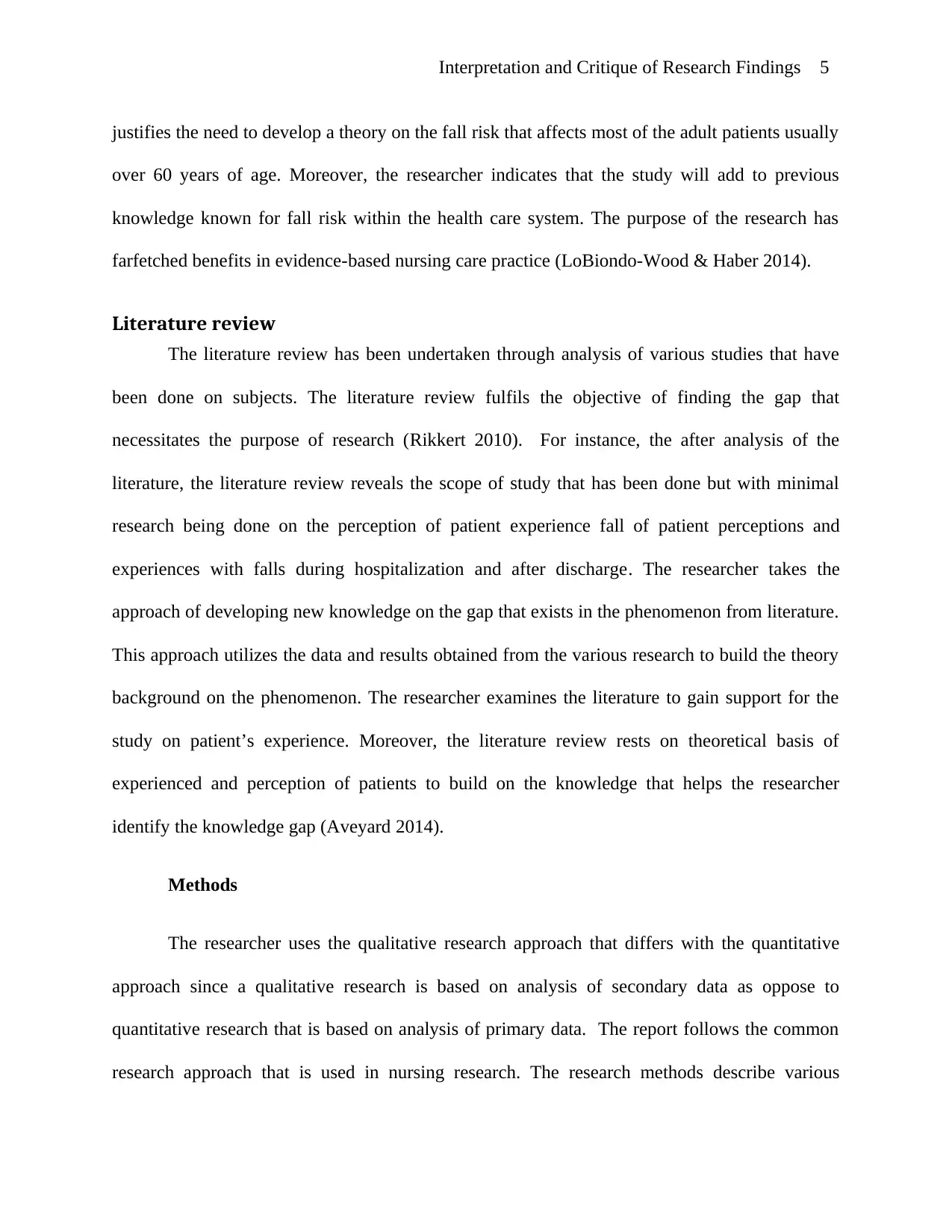
Interpretation and Critique of Research Findings 5
justifies the need to develop a theory on the fall risk that affects most of the adult patients usually
over 60 years of age. Moreover, the researcher indicates that the study will add to previous
knowledge known for fall risk within the health care system. The purpose of the research has
farfetched benefits in evidence-based nursing care practice (LoBiondo-Wood & Haber 2014).
Literature review
The literature review has been undertaken through analysis of various studies that have
been done on subjects. The literature review fulfils the objective of finding the gap that
necessitates the purpose of research (Rikkert 2010). For instance, the after analysis of the
literature, the literature review reveals the scope of study that has been done but with minimal
research being done on the perception of patient experience fall of patient perceptions and
experiences with falls during hospitalization and after discharge. The researcher takes the
approach of developing new knowledge on the gap that exists in the phenomenon from literature.
This approach utilizes the data and results obtained from the various research to build the theory
background on the phenomenon. The researcher examines the literature to gain support for the
study on patient’s experience. Moreover, the literature review rests on theoretical basis of
experienced and perception of patients to build on the knowledge that helps the researcher
identify the knowledge gap (Aveyard 2014).
Methods
The researcher uses the qualitative research approach that differs with the quantitative
approach since a qualitative research is based on analysis of secondary data as oppose to
quantitative research that is based on analysis of primary data. The report follows the common
research approach that is used in nursing research. The research methods describe various
justifies the need to develop a theory on the fall risk that affects most of the adult patients usually
over 60 years of age. Moreover, the researcher indicates that the study will add to previous
knowledge known for fall risk within the health care system. The purpose of the research has
farfetched benefits in evidence-based nursing care practice (LoBiondo-Wood & Haber 2014).
Literature review
The literature review has been undertaken through analysis of various studies that have
been done on subjects. The literature review fulfils the objective of finding the gap that
necessitates the purpose of research (Rikkert 2010). For instance, the after analysis of the
literature, the literature review reveals the scope of study that has been done but with minimal
research being done on the perception of patient experience fall of patient perceptions and
experiences with falls during hospitalization and after discharge. The researcher takes the
approach of developing new knowledge on the gap that exists in the phenomenon from literature.
This approach utilizes the data and results obtained from the various research to build the theory
background on the phenomenon. The researcher examines the literature to gain support for the
study on patient’s experience. Moreover, the literature review rests on theoretical basis of
experienced and perception of patients to build on the knowledge that helps the researcher
identify the knowledge gap (Aveyard 2014).
Methods
The researcher uses the qualitative research approach that differs with the quantitative
approach since a qualitative research is based on analysis of secondary data as oppose to
quantitative research that is based on analysis of primary data. The report follows the common
research approach that is used in nursing research. The research methods describe various
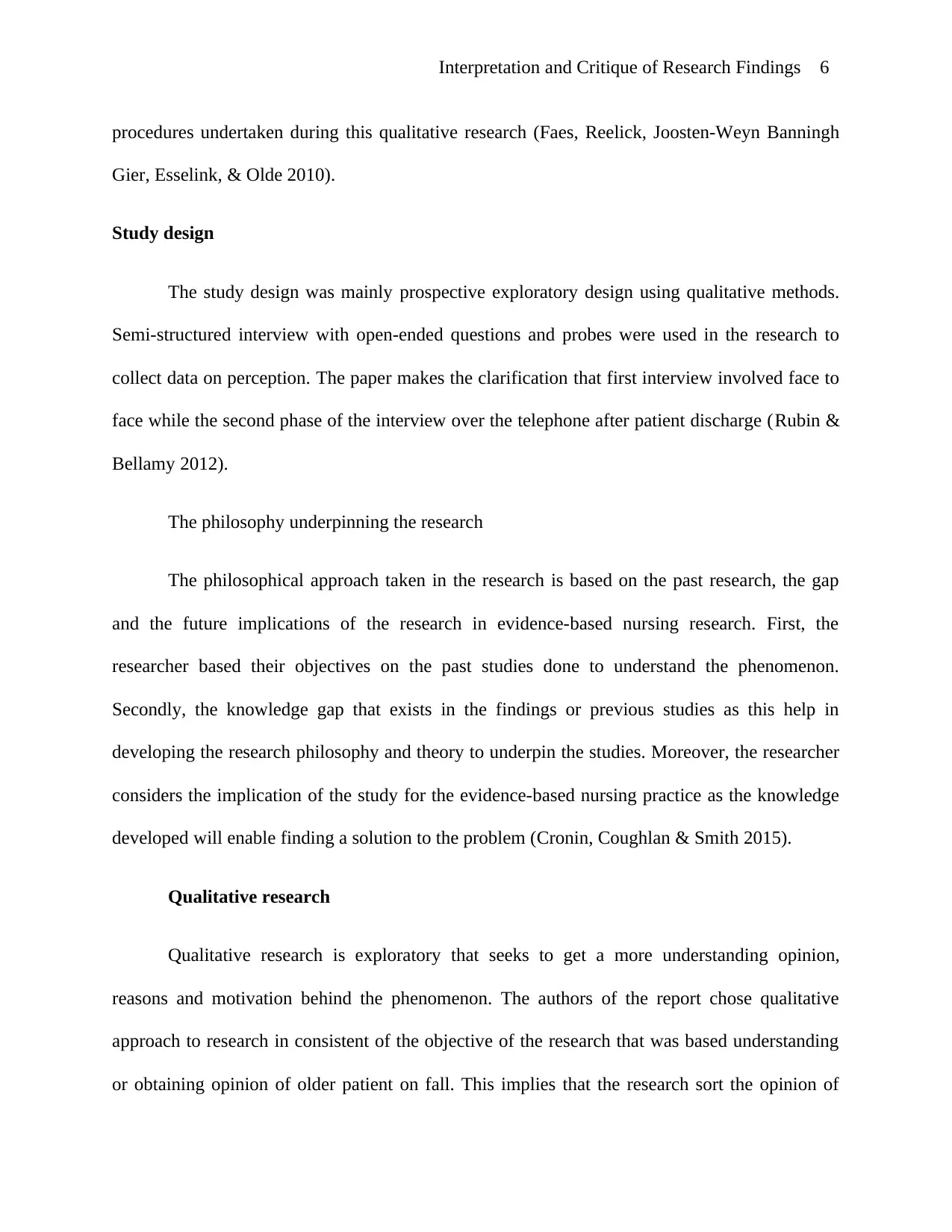
Interpretation and Critique of Research Findings 6
procedures undertaken during this qualitative research (Faes, Reelick, Joosten-Weyn Banningh
Gier, Esselink, & Olde 2010).
Study design
The study design was mainly prospective exploratory design using qualitative methods.
Semi-structured interview with open-ended questions and probes were used in the research to
collect data on perception. The paper makes the clarification that first interview involved face to
face while the second phase of the interview over the telephone after patient discharge (Rubin &
Bellamy 2012).
The philosophy underpinning the research
The philosophical approach taken in the research is based on the past research, the gap
and the future implications of the research in evidence-based nursing research. First, the
researcher based their objectives on the past studies done to understand the phenomenon.
Secondly, the knowledge gap that exists in the findings or previous studies as this help in
developing the research philosophy and theory to underpin the studies. Moreover, the researcher
considers the implication of the study for the evidence-based nursing practice as the knowledge
developed will enable finding a solution to the problem (Cronin, Coughlan & Smith 2015).
Qualitative research
Qualitative research is exploratory that seeks to get a more understanding opinion,
reasons and motivation behind the phenomenon. The authors of the report chose qualitative
approach to research in consistent of the objective of the research that was based understanding
or obtaining opinion of older patient on fall. This implies that the research sort the opinion of
procedures undertaken during this qualitative research (Faes, Reelick, Joosten-Weyn Banningh
Gier, Esselink, & Olde 2010).
Study design
The study design was mainly prospective exploratory design using qualitative methods.
Semi-structured interview with open-ended questions and probes were used in the research to
collect data on perception. The paper makes the clarification that first interview involved face to
face while the second phase of the interview over the telephone after patient discharge (Rubin &
Bellamy 2012).
The philosophy underpinning the research
The philosophical approach taken in the research is based on the past research, the gap
and the future implications of the research in evidence-based nursing research. First, the
researcher based their objectives on the past studies done to understand the phenomenon.
Secondly, the knowledge gap that exists in the findings or previous studies as this help in
developing the research philosophy and theory to underpin the studies. Moreover, the researcher
considers the implication of the study for the evidence-based nursing practice as the knowledge
developed will enable finding a solution to the problem (Cronin, Coughlan & Smith 2015).
Qualitative research
Qualitative research is exploratory that seeks to get a more understanding opinion,
reasons and motivation behind the phenomenon. The authors of the report chose qualitative
approach to research in consistent of the objective of the research that was based understanding
or obtaining opinion of older patient on fall. This implies that the research sort the opinion of
⊘ This is a preview!⊘
Do you want full access?
Subscribe today to unlock all pages.

Trusted by 1+ million students worldwide
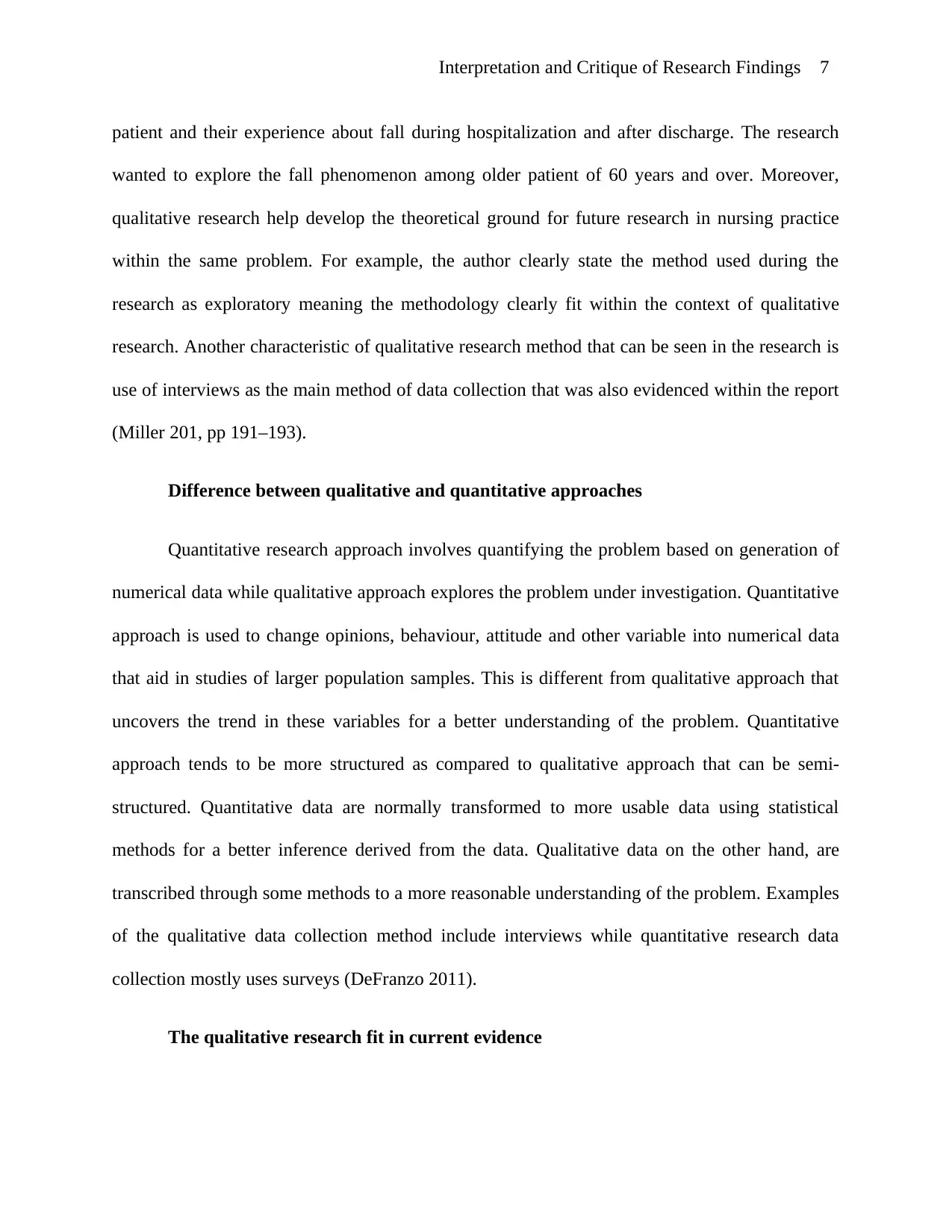
Interpretation and Critique of Research Findings 7
patient and their experience about fall during hospitalization and after discharge. The research
wanted to explore the fall phenomenon among older patient of 60 years and over. Moreover,
qualitative research help develop the theoretical ground for future research in nursing practice
within the same problem. For example, the author clearly state the method used during the
research as exploratory meaning the methodology clearly fit within the context of qualitative
research. Another characteristic of qualitative research method that can be seen in the research is
use of interviews as the main method of data collection that was also evidenced within the report
(Miller 201, pp 191–193).
Difference between qualitative and quantitative approaches
Quantitative research approach involves quantifying the problem based on generation of
numerical data while qualitative approach explores the problem under investigation. Quantitative
approach is used to change opinions, behaviour, attitude and other variable into numerical data
that aid in studies of larger population samples. This is different from qualitative approach that
uncovers the trend in these variables for a better understanding of the problem. Quantitative
approach tends to be more structured as compared to qualitative approach that can be semi-
structured. Quantitative data are normally transformed to more usable data using statistical
methods for a better inference derived from the data. Qualitative data on the other hand, are
transcribed through some methods to a more reasonable understanding of the problem. Examples
of the qualitative data collection method include interviews while quantitative research data
collection mostly uses surveys (DeFranzo 2011).
The qualitative research fit in current evidence
patient and their experience about fall during hospitalization and after discharge. The research
wanted to explore the fall phenomenon among older patient of 60 years and over. Moreover,
qualitative research help develop the theoretical ground for future research in nursing practice
within the same problem. For example, the author clearly state the method used during the
research as exploratory meaning the methodology clearly fit within the context of qualitative
research. Another characteristic of qualitative research method that can be seen in the research is
use of interviews as the main method of data collection that was also evidenced within the report
(Miller 201, pp 191–193).
Difference between qualitative and quantitative approaches
Quantitative research approach involves quantifying the problem based on generation of
numerical data while qualitative approach explores the problem under investigation. Quantitative
approach is used to change opinions, behaviour, attitude and other variable into numerical data
that aid in studies of larger population samples. This is different from qualitative approach that
uncovers the trend in these variables for a better understanding of the problem. Quantitative
approach tends to be more structured as compared to qualitative approach that can be semi-
structured. Quantitative data are normally transformed to more usable data using statistical
methods for a better inference derived from the data. Qualitative data on the other hand, are
transcribed through some methods to a more reasonable understanding of the problem. Examples
of the qualitative data collection method include interviews while quantitative research data
collection mostly uses surveys (DeFranzo 2011).
The qualitative research fit in current evidence
Paraphrase This Document
Need a fresh take? Get an instant paraphrase of this document with our AI Paraphraser
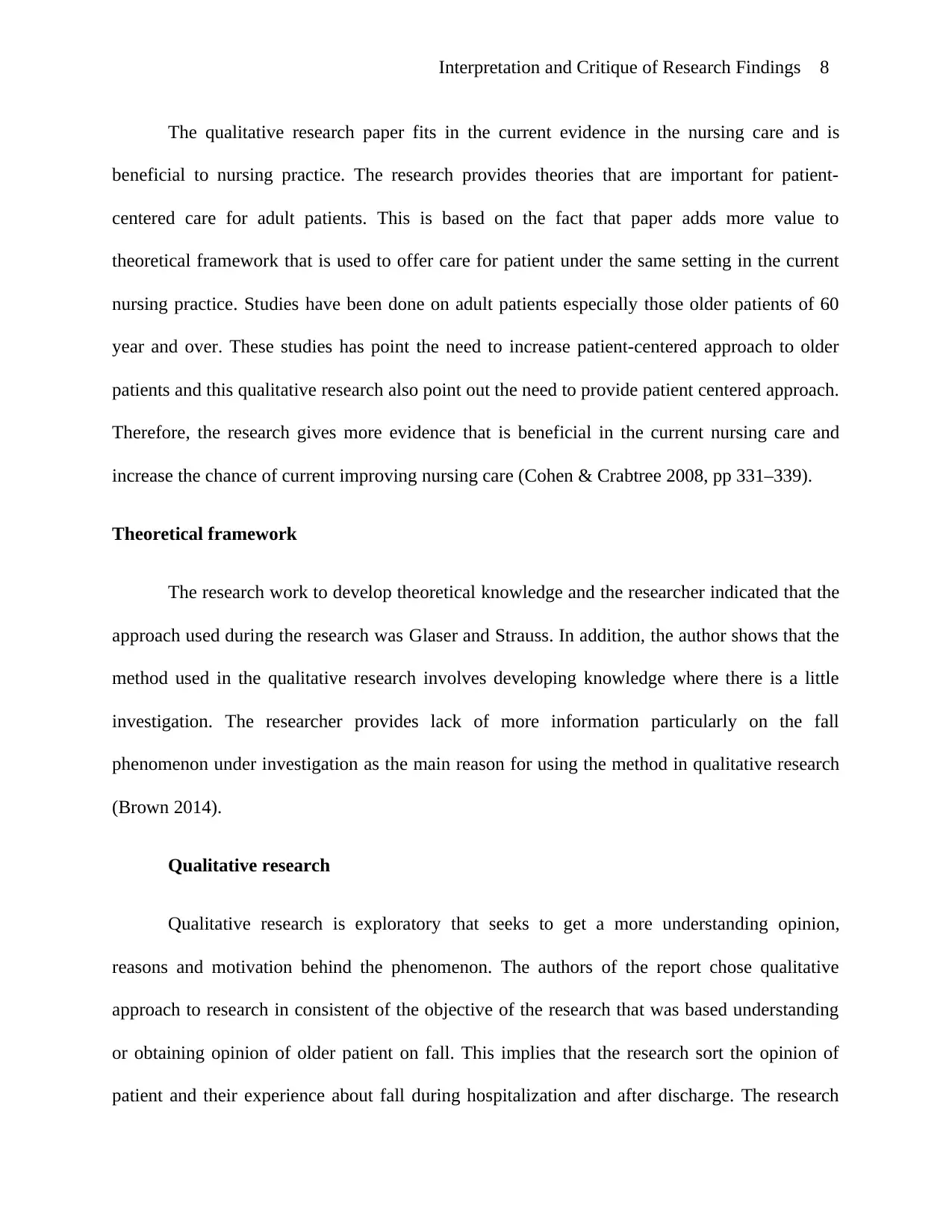
Interpretation and Critique of Research Findings 8
The qualitative research paper fits in the current evidence in the nursing care and is
beneficial to nursing practice. The research provides theories that are important for patient-
centered care for adult patients. This is based on the fact that paper adds more value to
theoretical framework that is used to offer care for patient under the same setting in the current
nursing practice. Studies have been done on adult patients especially those older patients of 60
year and over. These studies has point the need to increase patient-centered approach to older
patients and this qualitative research also point out the need to provide patient centered approach.
Therefore, the research gives more evidence that is beneficial in the current nursing care and
increase the chance of current improving nursing care (Cohen & Crabtree 2008, pp 331–339).
Theoretical framework
The research work to develop theoretical knowledge and the researcher indicated that the
approach used during the research was Glaser and Strauss. In addition, the author shows that the
method used in the qualitative research involves developing knowledge where there is a little
investigation. The researcher provides lack of more information particularly on the fall
phenomenon under investigation as the main reason for using the method in qualitative research
(Brown 2014).
Qualitative research
Qualitative research is exploratory that seeks to get a more understanding opinion,
reasons and motivation behind the phenomenon. The authors of the report chose qualitative
approach to research in consistent of the objective of the research that was based understanding
or obtaining opinion of older patient on fall. This implies that the research sort the opinion of
patient and their experience about fall during hospitalization and after discharge. The research
The qualitative research paper fits in the current evidence in the nursing care and is
beneficial to nursing practice. The research provides theories that are important for patient-
centered care for adult patients. This is based on the fact that paper adds more value to
theoretical framework that is used to offer care for patient under the same setting in the current
nursing practice. Studies have been done on adult patients especially those older patients of 60
year and over. These studies has point the need to increase patient-centered approach to older
patients and this qualitative research also point out the need to provide patient centered approach.
Therefore, the research gives more evidence that is beneficial in the current nursing care and
increase the chance of current improving nursing care (Cohen & Crabtree 2008, pp 331–339).
Theoretical framework
The research work to develop theoretical knowledge and the researcher indicated that the
approach used during the research was Glaser and Strauss. In addition, the author shows that the
method used in the qualitative research involves developing knowledge where there is a little
investigation. The researcher provides lack of more information particularly on the fall
phenomenon under investigation as the main reason for using the method in qualitative research
(Brown 2014).
Qualitative research
Qualitative research is exploratory that seeks to get a more understanding opinion,
reasons and motivation behind the phenomenon. The authors of the report chose qualitative
approach to research in consistent of the objective of the research that was based understanding
or obtaining opinion of older patient on fall. This implies that the research sort the opinion of
patient and their experience about fall during hospitalization and after discharge. The research
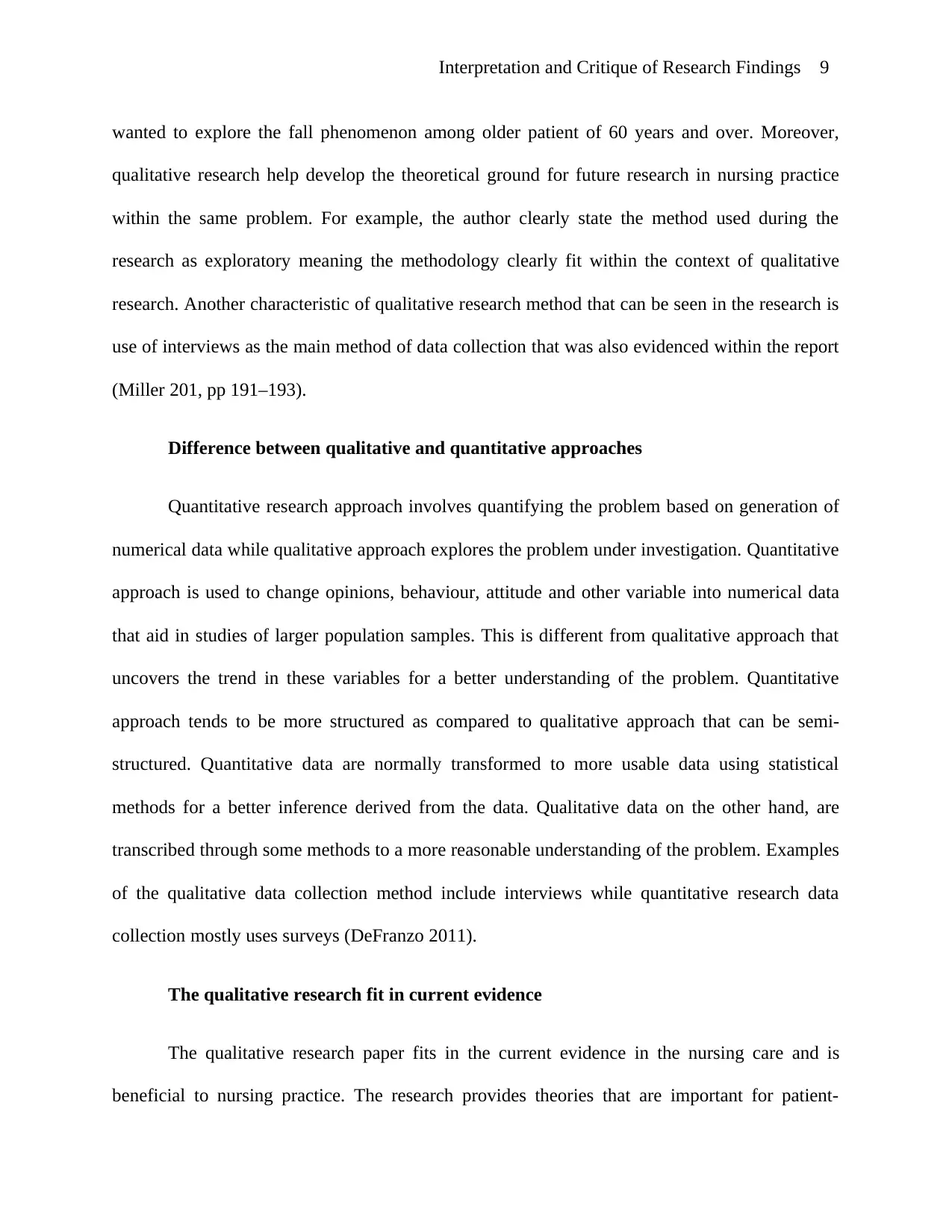
Interpretation and Critique of Research Findings 9
wanted to explore the fall phenomenon among older patient of 60 years and over. Moreover,
qualitative research help develop the theoretical ground for future research in nursing practice
within the same problem. For example, the author clearly state the method used during the
research as exploratory meaning the methodology clearly fit within the context of qualitative
research. Another characteristic of qualitative research method that can be seen in the research is
use of interviews as the main method of data collection that was also evidenced within the report
(Miller 201, pp 191–193).
Difference between qualitative and quantitative approaches
Quantitative research approach involves quantifying the problem based on generation of
numerical data while qualitative approach explores the problem under investigation. Quantitative
approach is used to change opinions, behaviour, attitude and other variable into numerical data
that aid in studies of larger population samples. This is different from qualitative approach that
uncovers the trend in these variables for a better understanding of the problem. Quantitative
approach tends to be more structured as compared to qualitative approach that can be semi-
structured. Quantitative data are normally transformed to more usable data using statistical
methods for a better inference derived from the data. Qualitative data on the other hand, are
transcribed through some methods to a more reasonable understanding of the problem. Examples
of the qualitative data collection method include interviews while quantitative research data
collection mostly uses surveys (DeFranzo 2011).
The qualitative research fit in current evidence
The qualitative research paper fits in the current evidence in the nursing care and is
beneficial to nursing practice. The research provides theories that are important for patient-
wanted to explore the fall phenomenon among older patient of 60 years and over. Moreover,
qualitative research help develop the theoretical ground for future research in nursing practice
within the same problem. For example, the author clearly state the method used during the
research as exploratory meaning the methodology clearly fit within the context of qualitative
research. Another characteristic of qualitative research method that can be seen in the research is
use of interviews as the main method of data collection that was also evidenced within the report
(Miller 201, pp 191–193).
Difference between qualitative and quantitative approaches
Quantitative research approach involves quantifying the problem based on generation of
numerical data while qualitative approach explores the problem under investigation. Quantitative
approach is used to change opinions, behaviour, attitude and other variable into numerical data
that aid in studies of larger population samples. This is different from qualitative approach that
uncovers the trend in these variables for a better understanding of the problem. Quantitative
approach tends to be more structured as compared to qualitative approach that can be semi-
structured. Quantitative data are normally transformed to more usable data using statistical
methods for a better inference derived from the data. Qualitative data on the other hand, are
transcribed through some methods to a more reasonable understanding of the problem. Examples
of the qualitative data collection method include interviews while quantitative research data
collection mostly uses surveys (DeFranzo 2011).
The qualitative research fit in current evidence
The qualitative research paper fits in the current evidence in the nursing care and is
beneficial to nursing practice. The research provides theories that are important for patient-
⊘ This is a preview!⊘
Do you want full access?
Subscribe today to unlock all pages.

Trusted by 1+ million students worldwide
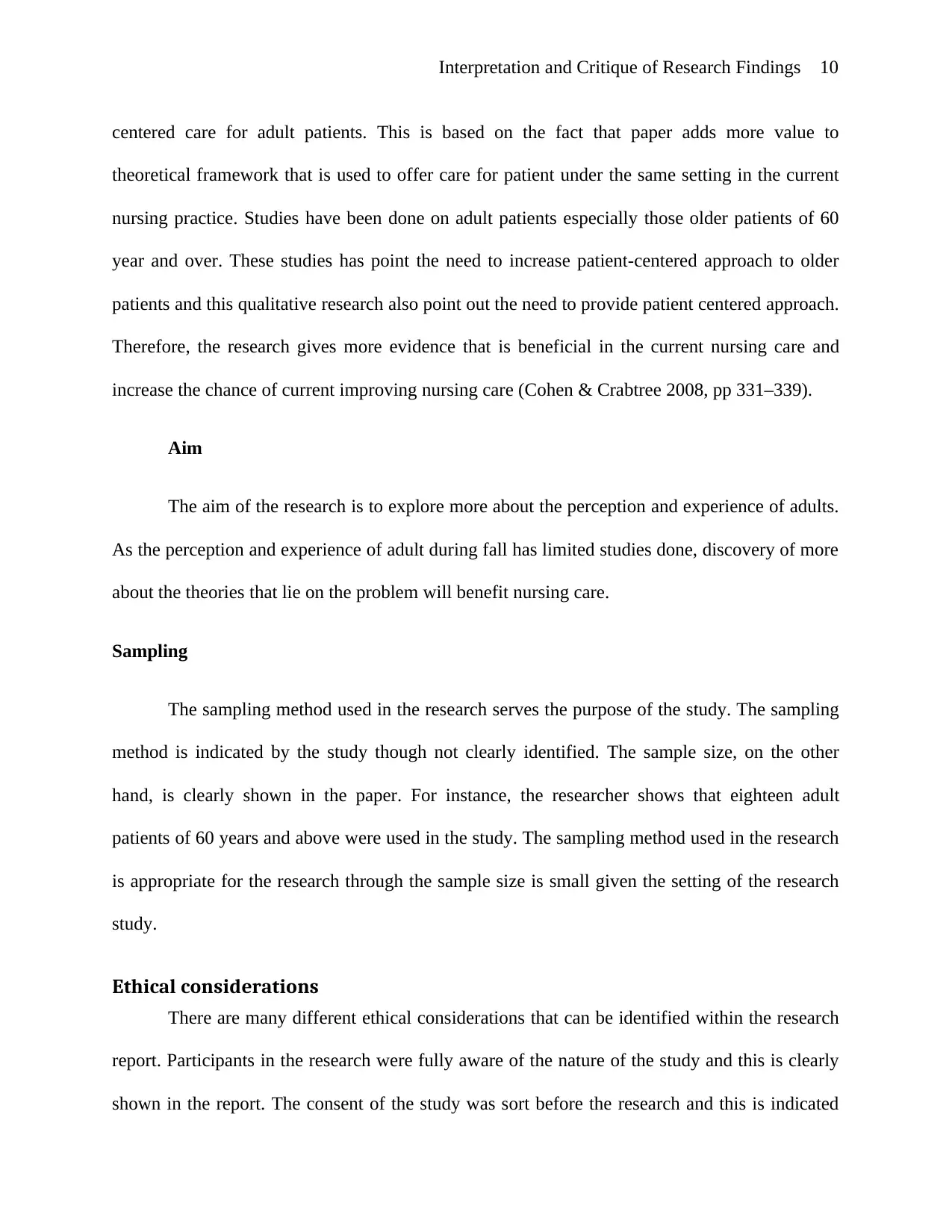
Interpretation and Critique of Research Findings 10
centered care for adult patients. This is based on the fact that paper adds more value to
theoretical framework that is used to offer care for patient under the same setting in the current
nursing practice. Studies have been done on adult patients especially those older patients of 60
year and over. These studies has point the need to increase patient-centered approach to older
patients and this qualitative research also point out the need to provide patient centered approach.
Therefore, the research gives more evidence that is beneficial in the current nursing care and
increase the chance of current improving nursing care (Cohen & Crabtree 2008, pp 331–339).
Aim
The aim of the research is to explore more about the perception and experience of adults.
As the perception and experience of adult during fall has limited studies done, discovery of more
about the theories that lie on the problem will benefit nursing care.
Sampling
The sampling method used in the research serves the purpose of the study. The sampling
method is indicated by the study though not clearly identified. The sample size, on the other
hand, is clearly shown in the paper. For instance, the researcher shows that eighteen adult
patients of 60 years and above were used in the study. The sampling method used in the research
is appropriate for the research through the sample size is small given the setting of the research
study.
Ethical considerations
There are many different ethical considerations that can be identified within the research
report. Participants in the research were fully aware of the nature of the study and this is clearly
shown in the report. The consent of the study was sort before the research and this is indicated
centered care for adult patients. This is based on the fact that paper adds more value to
theoretical framework that is used to offer care for patient under the same setting in the current
nursing practice. Studies have been done on adult patients especially those older patients of 60
year and over. These studies has point the need to increase patient-centered approach to older
patients and this qualitative research also point out the need to provide patient centered approach.
Therefore, the research gives more evidence that is beneficial in the current nursing care and
increase the chance of current improving nursing care (Cohen & Crabtree 2008, pp 331–339).
Aim
The aim of the research is to explore more about the perception and experience of adults.
As the perception and experience of adult during fall has limited studies done, discovery of more
about the theories that lie on the problem will benefit nursing care.
Sampling
The sampling method used in the research serves the purpose of the study. The sampling
method is indicated by the study though not clearly identified. The sample size, on the other
hand, is clearly shown in the paper. For instance, the researcher shows that eighteen adult
patients of 60 years and above were used in the study. The sampling method used in the research
is appropriate for the research through the sample size is small given the setting of the research
study.
Ethical considerations
There are many different ethical considerations that can be identified within the research
report. Participants in the research were fully aware of the nature of the study and this is clearly
shown in the report. The consent of the study was sort before the research and this is indicated
Paraphrase This Document
Need a fresh take? Get an instant paraphrase of this document with our AI Paraphraser
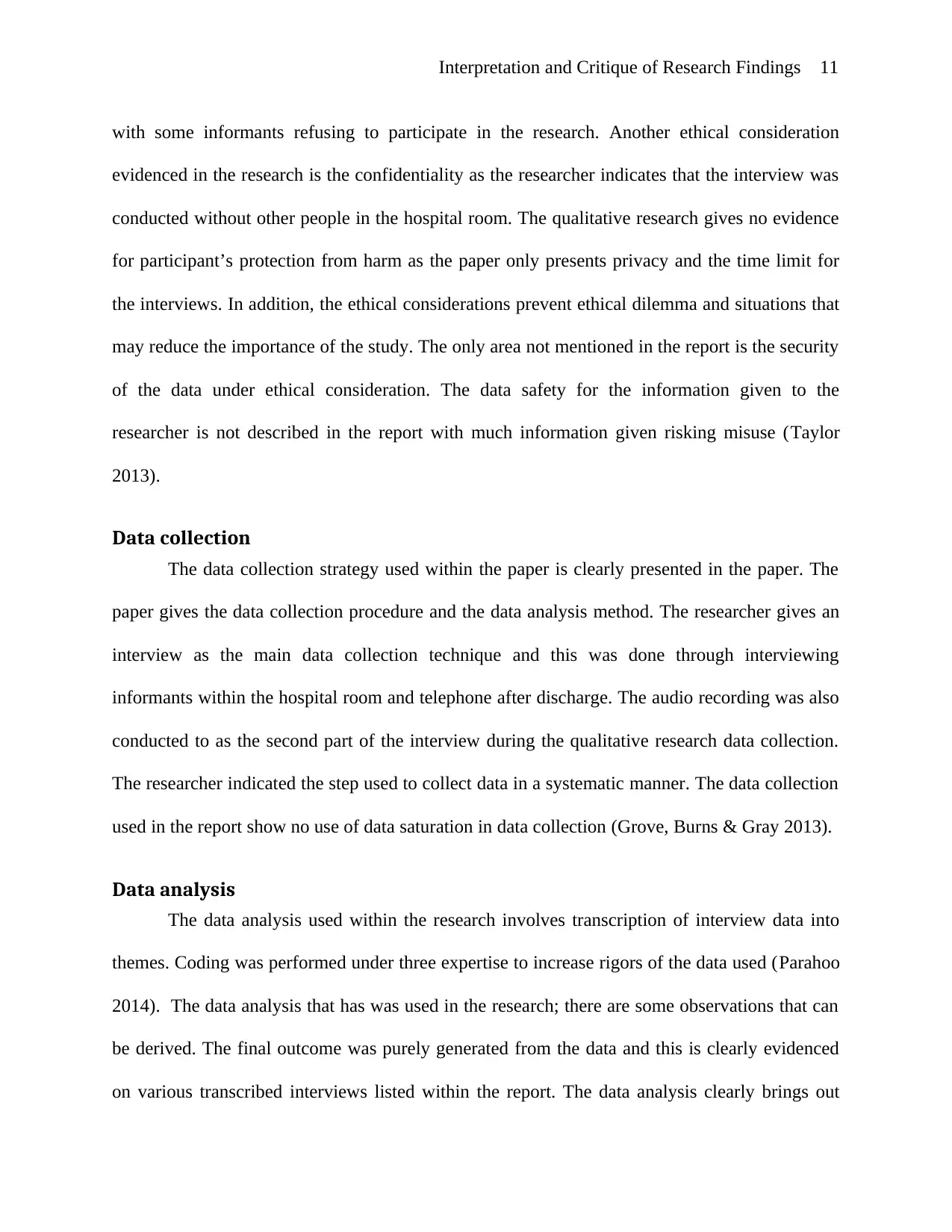
Interpretation and Critique of Research Findings 11
with some informants refusing to participate in the research. Another ethical consideration
evidenced in the research is the confidentiality as the researcher indicates that the interview was
conducted without other people in the hospital room. The qualitative research gives no evidence
for participant’s protection from harm as the paper only presents privacy and the time limit for
the interviews. In addition, the ethical considerations prevent ethical dilemma and situations that
may reduce the importance of the study. The only area not mentioned in the report is the security
of the data under ethical consideration. The data safety for the information given to the
researcher is not described in the report with much information given risking misuse (Taylor
2013).
Data collection
The data collection strategy used within the paper is clearly presented in the paper. The
paper gives the data collection procedure and the data analysis method. The researcher gives an
interview as the main data collection technique and this was done through interviewing
informants within the hospital room and telephone after discharge. The audio recording was also
conducted to as the second part of the interview during the qualitative research data collection.
The researcher indicated the step used to collect data in a systematic manner. The data collection
used in the report show no use of data saturation in data collection (Grove, Burns & Gray 2013).
Data analysis
The data analysis used within the research involves transcription of interview data into
themes. Coding was performed under three expertise to increase rigors of the data used (Parahoo
2014). The data analysis that has was used in the research; there are some observations that can
be derived. The final outcome was purely generated from the data and this is clearly evidenced
on various transcribed interviews listed within the report. The data analysis clearly brings out
with some informants refusing to participate in the research. Another ethical consideration
evidenced in the research is the confidentiality as the researcher indicates that the interview was
conducted without other people in the hospital room. The qualitative research gives no evidence
for participant’s protection from harm as the paper only presents privacy and the time limit for
the interviews. In addition, the ethical considerations prevent ethical dilemma and situations that
may reduce the importance of the study. The only area not mentioned in the report is the security
of the data under ethical consideration. The data safety for the information given to the
researcher is not described in the report with much information given risking misuse (Taylor
2013).
Data collection
The data collection strategy used within the paper is clearly presented in the paper. The
paper gives the data collection procedure and the data analysis method. The researcher gives an
interview as the main data collection technique and this was done through interviewing
informants within the hospital room and telephone after discharge. The audio recording was also
conducted to as the second part of the interview during the qualitative research data collection.
The researcher indicated the step used to collect data in a systematic manner. The data collection
used in the report show no use of data saturation in data collection (Grove, Burns & Gray 2013).
Data analysis
The data analysis used within the research involves transcription of interview data into
themes. Coding was performed under three expertise to increase rigors of the data used (Parahoo
2014). The data analysis that has was used in the research; there are some observations that can
be derived. The final outcome was purely generated from the data and this is clearly evidenced
on various transcribed interviews listed within the report. The data analysis clearly brings out
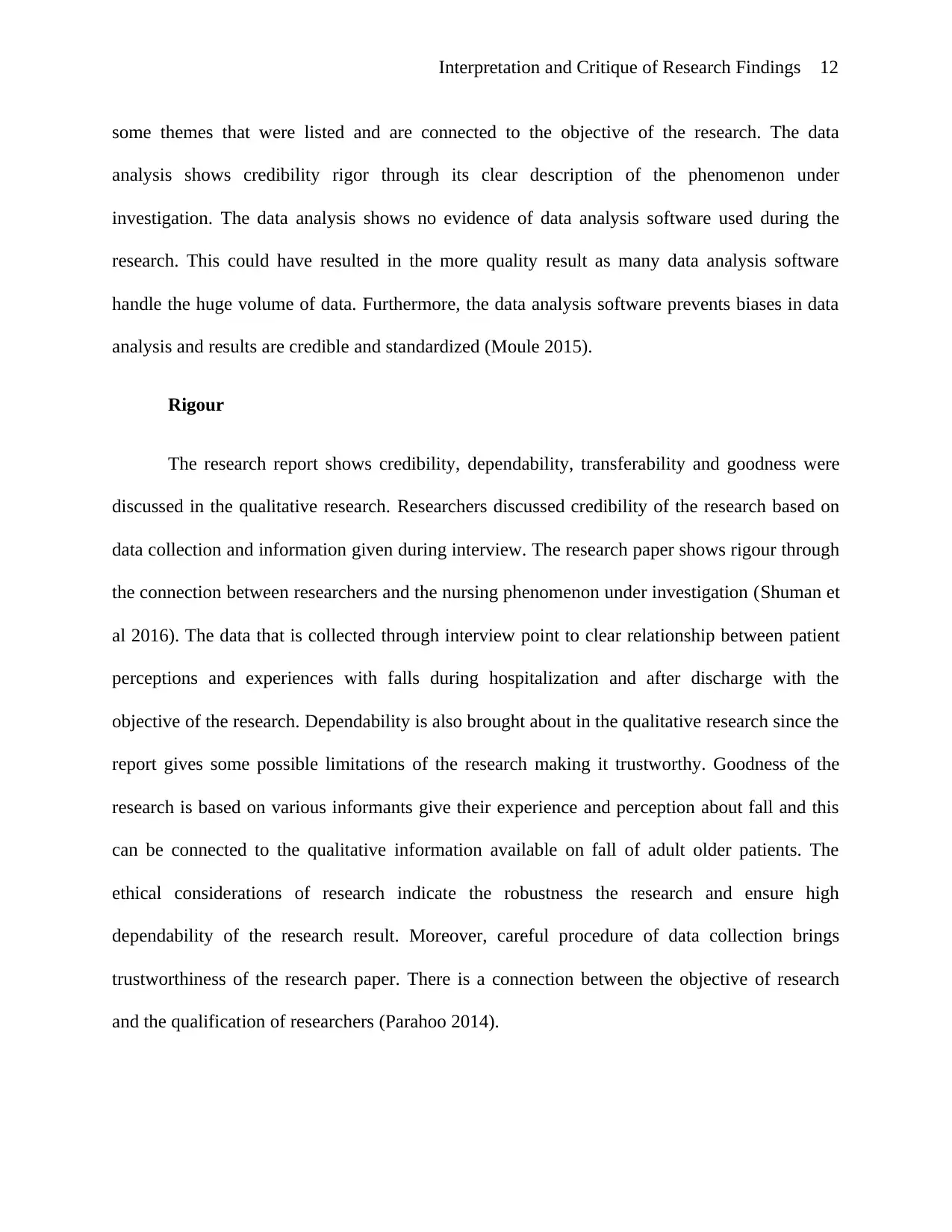
Interpretation and Critique of Research Findings 12
some themes that were listed and are connected to the objective of the research. The data
analysis shows credibility rigor through its clear description of the phenomenon under
investigation. The data analysis shows no evidence of data analysis software used during the
research. This could have resulted in the more quality result as many data analysis software
handle the huge volume of data. Furthermore, the data analysis software prevents biases in data
analysis and results are credible and standardized (Moule 2015).
Rigour
The research report shows credibility, dependability, transferability and goodness were
discussed in the qualitative research. Researchers discussed credibility of the research based on
data collection and information given during interview. The research paper shows rigour through
the connection between researchers and the nursing phenomenon under investigation (Shuman et
al 2016). The data that is collected through interview point to clear relationship between patient
perceptions and experiences with falls during hospitalization and after discharge with the
objective of the research. Dependability is also brought about in the qualitative research since the
report gives some possible limitations of the research making it trustworthy. Goodness of the
research is based on various informants give their experience and perception about fall and this
can be connected to the qualitative information available on fall of adult older patients. The
ethical considerations of research indicate the robustness the research and ensure high
dependability of the research result. Moreover, careful procedure of data collection brings
trustworthiness of the research paper. There is a connection between the objective of research
and the qualification of researchers (Parahoo 2014).
some themes that were listed and are connected to the objective of the research. The data
analysis shows credibility rigor through its clear description of the phenomenon under
investigation. The data analysis shows no evidence of data analysis software used during the
research. This could have resulted in the more quality result as many data analysis software
handle the huge volume of data. Furthermore, the data analysis software prevents biases in data
analysis and results are credible and standardized (Moule 2015).
Rigour
The research report shows credibility, dependability, transferability and goodness were
discussed in the qualitative research. Researchers discussed credibility of the research based on
data collection and information given during interview. The research paper shows rigour through
the connection between researchers and the nursing phenomenon under investigation (Shuman et
al 2016). The data that is collected through interview point to clear relationship between patient
perceptions and experiences with falls during hospitalization and after discharge with the
objective of the research. Dependability is also brought about in the qualitative research since the
report gives some possible limitations of the research making it trustworthy. Goodness of the
research is based on various informants give their experience and perception about fall and this
can be connected to the qualitative information available on fall of adult older patients. The
ethical considerations of research indicate the robustness the research and ensure high
dependability of the research result. Moreover, careful procedure of data collection brings
trustworthiness of the research paper. There is a connection between the objective of research
and the qualification of researchers (Parahoo 2014).
⊘ This is a preview!⊘
Do you want full access?
Subscribe today to unlock all pages.

Trusted by 1+ million students worldwide
1 out of 18
Related Documents
Your All-in-One AI-Powered Toolkit for Academic Success.
+13062052269
info@desklib.com
Available 24*7 on WhatsApp / Email
![[object Object]](/_next/static/media/star-bottom.7253800d.svg)
Unlock your academic potential
Copyright © 2020–2025 A2Z Services. All Rights Reserved. Developed and managed by ZUCOL.





